Culinary terms used daily in Indian kitchens
Indian Culinary terms Culinary terms are very essential in the world of cooking. To become a skilled chef, first one needs to learn the technical vocabulary (language) of culinary arts. Cooking is an art of creating something consumable as well as delicious. Thus it is very essential to know the basic terms that are used in cooking. Once the language of culinary arts is understood, one will be able to interpret and communicate information accurately.
Some of the basic culinary terms of cooking that are widely used in India are as follows:
1. Baghar (Tempering)
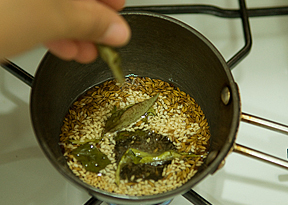
Baghar or Tempering
“Tempering” is either done as the first step in the cooking process, before adding the vegetables. Spices and herbs are added one at a time to hot oil. For example, or as the last, pouring the tempered oil over dal. The oil extracts and retains all the sharp flavours of all the spices and coats the entire dish being prepared. “Baghar” or “Tempering” is also known as “Tadka” or “Chonk”.
2. Balchao (Pickling)
A Goan speciality where vegetables like aubergines, cucumber, okra, green chillies etc are “pickled” in sugar, vinegar and spices for a day or two before eating.
3. Bhunao (Sauté/stir-fry)
While frying the spices such as onion, garlic, tomatoes, chillies etc in oil it sometimes sticks to the pan due to over heating. So to save it from sticking and to help it cook evenly small quantities of water, yogurt or stalk is added to the masala and when it is done and separates oil from the mixture, the main ingredient like vegetables are added to it.
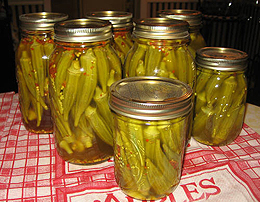
Balchao or Pickling
4. Bhunna (Roasting)
In India, roasting of several spices without using any oil is popularly known as “Bhunna”. As the spices release its aroma, the spices are being properly roasted. This smoky flavour is appreciated by all.
5. Bukhara
Dum Pukht cuisine in India is over 200 years old. During the famine of 1784 when Nawab Asaf-ud-Daulah was building the Bara Imambara so that employment could be created for the starving people, huge quantities of food was cooked in large vessels, degs, in massive double-walled ovens called “Bukharis”. He tasted the food one night and loved it so much that “Bukhari” cooking was incorporated into the royal court.
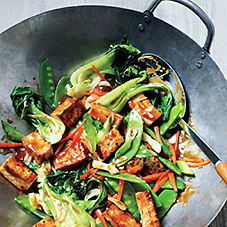
Bhunao or Stir Fry
6. Dhungaar (Smoking)
Glowing charcoal is placed in a small katori, or bowl, cooked food is placed around this. Dry spices and ghee are poured on top of the coals and a lid is quickly placed over the food. This smoking adds a delicate flavour to the prepared food. In Rajasthan, for example, dal is prepared and a small bowl with burning coal is placed in it and then ghee poured over it and the lid quickly closed. This gives a smoky flavour to the dal.
7. Do-Piaza
Mullah Do-Piaza, was the legendary cook at Akbar’s court. One of the navratnas, it is said he could cook up culinary delights using only two Piaz (onions). For example paneer cooked in that particular style is called Paneer do Piaza.
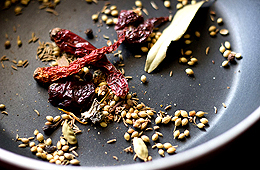
Bhunna or Dry Roast
8. Dum (Steaming)
In the olden days, the utensil was sealed with atta (dough) to capture the moisture within the food as it cooked slowly over a charcoal fire. Some coal was placed on the lid to ensure even cooking. The food continued to cook in its own steam, retaining all its flavour and aroma. Dum means “to steam” or “mature” a dish.
9. Handi
The cooking is done in a thick bottom pan so that the food does not stick or burn; the lid helps retain the aroma and flavour. Both bhunao and dum are aspects of Handi cooking.
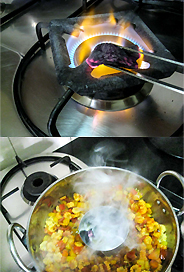
Dungaar or Smoking
10. Kadhai (Round bottomed pan)
Usually the kadhai, in which the food is cooked, is placed directly on the table, where everyone eats out of it. Kadhai cooking is quick and no water is used in this style of cooking. The main ingredients cook in the natural juices released by the tomatoes and meat in the dish, which is constantly stirred until cooked.
11. Sekna (Baking)
A wired rack utensil used to cook roti or chapatti on fire is known as “Sekna” in Indian language. It is an Indian process of baking the flat bread directly on fire with the help of using a wired rack to hold the bread of fire. This is an age old technique of cooking breads.
12. Talna (Frying)
In Indian cooking frying, when it is called for, is done in a wok or kadhai. The round bottom uses less oil and cooks the food evenly. In a kadhai, some amount of oil is heated and then the vegetables are added to the hot oil to fry evenly. This process is known as “Talna”.
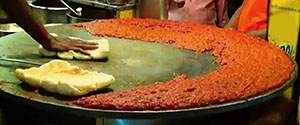
Tawa or Hot Plate
13. Tawa (Hot Plate)
A thicker version of the household griddle, it is used to cook food very fast; the outer rim is used to keep the food warm. Pav Bhaji is a typical tawa dish and needs to be constantly stirred to avoid burning, and like kadhai cooking is eaten immediately.
14. Ubalna (Boiling)
In cooking, the first step is to boil the raw vegetables in water. This process of cooking the raw vegetables is known as “Ubalna” in Hindi language. This process makes the raw form of food into a tenderly cooked form.
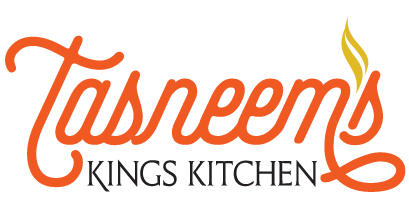
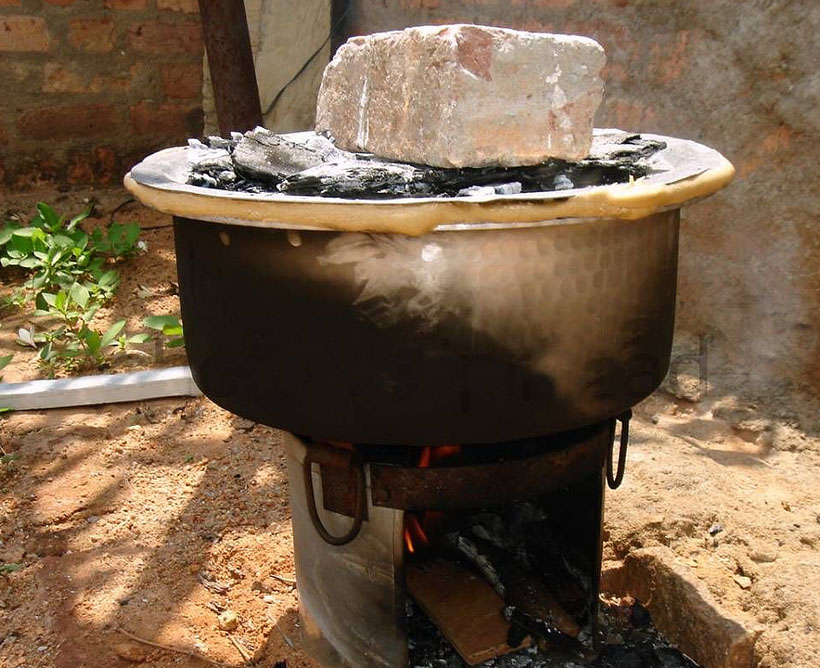
Comments are closed.